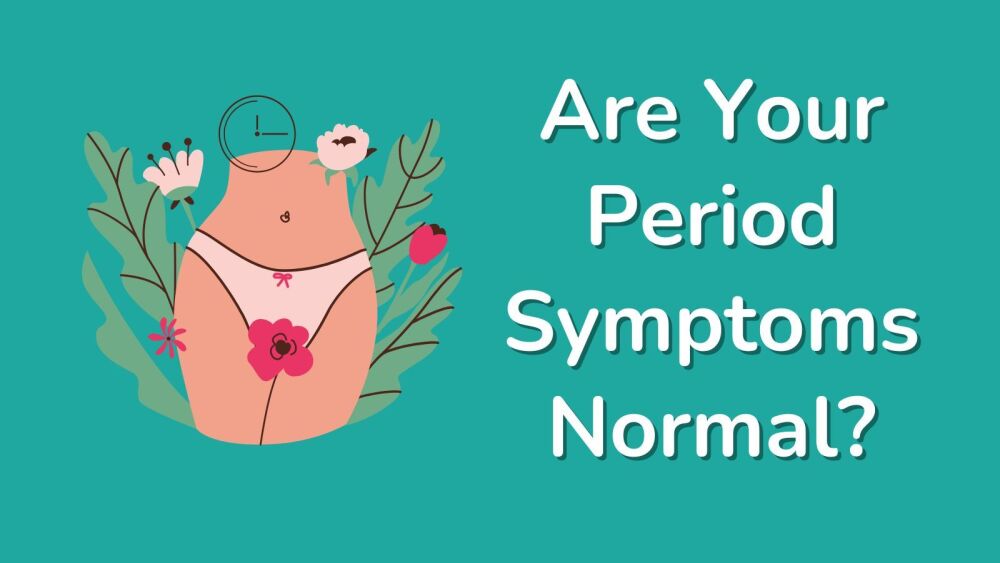Signs of Menstruation. Are Your Period Symptoms Normal?
Posted on
Ah, the mysterious dance of hormones, the subtle shifts in mood, and the undeniable presence of cramps – it’s all part of the fascinating world of menstruation. Whether you're a seasoned veteran or just beginning to navigate this natural cycle, understanding what's normal can make a world of difference.
Join us as we delve into the intricacies of your monthly visitor, uncovering the signs and symptoms that make up your menstrual cycle. From the subtle cues of the follicular phase to the more pronounced changes of the luteal phase, we'll decode the language your body speaks every month.
But fear not, this isn't just another dry biology lesson. We'll break down the science into bite-sized pieces, accompanied by helpful visuals and practical tips to navigate those inevitable ups and downs.
So, grab a cuppa and settle in as we embark on this empowering journey to demystify menstruation and reclaim control over our bodies. After all, understanding your menstrual cycle isn't just about managing symptoms – it's about embracing the beautiful complexity of being a woman.
Let's dive in!

Are My Periods Normal? Understanding the Menstrual Cycle
Many women go through life wondering whether their period symptoms are normal. Surely nature didn’t invent this crazy emotional and often painful monthly rollercoaster, did it?
Before we dive into the symptoms of menstruation, it's important to understand the menstrual cycle. The menstrual cycle is a series of changes that occur in a woman's body each month to prepare for pregnancy. It's divided into two phases: the follicular phase and the luteal phase.
The follicular phase begins on the first day of your period and lasts until ovulation (when an egg is released from the ovary). During this phase, the body produces hormones (estrogen and follicle-stimulating hormone) that stimulate the ovaries to produce an egg.
The luteal phase begins after ovulation and lasts until the start of your next period. During this phase, the body produces hormones (progesterone and luteinizing hormone) that help prepare the uterus for a potential pregnancy.
Below we share some of the symptoms of each stage of the menstural cycle so you know what to expect.
Symptoms of the Menstrual Cycle Phases
Now that we understand the menstrual cycle phases, let's take a look at some common symptoms associated with each phase:
Follicular Phase Symptoms:
- Light menstrual flow
- Mild cramping
- Breast tenderness
- Increased sex drive
- Mood swings
Luteal Phase Symptoms:
- Heavier menstrual flow
- Bloating
- Acne
- Irritability
- Fatigue
It's important to note that everyone's menstrual cycle is different, and symptoms can vary widely. Some women may experience very few symptoms, while others may experience more severe symptoms.
Common Menstruation Symptoms
In addition to the symptoms associated with the menstrual cycle phases, there are also common symptoms that many women experience during their period. These include:
- Cramps
- Bloating
- Headaches
- Mood swings
- Fatigue
- Breast tenderness
- Acne
- Food cravings
Factors That Affect Menstruation Cycle Symptoms
There are several factors that can affect the severity of menstruation symptoms, including:
- Age: Younger women may experience more severe symptoms than older women.
- Stress: High levels of stress can exacerbate symptoms.
- Underlying health conditions: Conditions such as endometriosis or polycystic ovary syndrome (PCOS) can cause more severe symptoms.
- Lifestyle factors: A healthy diet and regular exercise can help reduce symptoms.
Understanding the Luteal Phase: What’s Happening in Your Body?
The luteal phase occurs after ovulation and lasts until the start of your period. This is when progesterone levels rise, preparing the uterus for a potential pregnancy. If fertilisation doesn’t occur, hormone levels drop, leading to menstruation.
Common luteal phase symptoms include:
- Bloating due to water retention.
- Breast tenderness from increased progesterone.
- Mood swings and irritability as hormones fluctuate.
- Increased appetite or food cravings.
- Fatigue due to rising basal body temperature.
How to Manage Luteal Phase Symptoms
- Increase magnesium-rich foods (leafy greens, nuts) to reduce bloating and anxiety.
- Stay hydrated to prevent water retention.
- Exercise moderately to boost mood and energy levels.
- Consider herbal teas like chamomile for relaxation.
If symptoms severely impact your daily life, you may wish to speak with a healthcare provider to explore hormonal balance options. Or you may decide to ride it out and stay natural. The choice is up to you.
Luteal Phase vs. PMS: How to Tell the Difference?
Many people mistake normal luteal phase symptoms for PMS, but they’re not the same.
- Luteal phase symptoms are mild and naturally occur as progesterone rises.
- PMS (Premenstrual Syndrome) is more severe, often interfering with daily life.
- PMDD (Premenstrual Dysphoric Disorder) is an extreme form of PMS, causing depression, anxiety, and mood swings.
How to Ease PMS Symptoms Naturally
- Increase Vitamin B6 (bananas, chickpeas) to reduce irritability.
- Get enough omega-3s (flaxseeds, walnuts) to combat inflammation.
- Practise deep breathing or yoga for stress relief.
- Consider herbal supplements like chasteberry for hormonal balance.
If PMS symptoms are severe or worsening, seek medical advice to rule out underlying hormonal conditions.
The Follicular Phase: How to Optimise Your Energy and Mood
The follicular phase starts on the first day of your period and ends with ovulation. This phase is marked by rising estrogen levels, leading to increased energy, focus, and mood stability.
What happens during this phase?
- Estrogen boosts serotonin, making you feel happier.
- Increased energy makes this the best time for intense workouts.
- Skin improves as estrogen regulates oil production.
- Brain function is enhanced, aiding productivity.
Ways to Support Your Body in the Follicular Phase
- Eat iron-rich foods (lentils, spinach) to replenish lost nutrients.
- Engage in strength training or cardio when energy levels peak.
- Focus on complex carbs and healthy fats to sustain energy.
- Practise mindfulness or journaling to capitalise on mental clarity.
By aligning lifestyle habits with hormonal fluctuations, you can maximise productivity and well-being during this phase.
Managing Menstruation Symptoms
While some discomfort during your period is normal, there are several things you can do to manage your symptoms:
- Over-the-counter pain relievers such as ibuprofen can help relieve cramps and headaches.
- Heating pads or hot water bottles can help alleviate cramps and abdominal pain.
- Exercise can help reduce bloating and improve mood.
- Eating a healthy diet rich in fruits, vegetables, and whole grains can help reduce symptoms.
We'll explore these in more detail at the end of the article.
Unexpected Period Symptoms: What’s Normal and What’s Not?
Most people associate periods with cramps, bloating, and mood swings, but some symptoms may be unexpected or concerning.
Lesser-Known But Normal Period Symptoms:
- Lower back pain – Often caused by uterine contractions.
- Digestive issues – Hormones can trigger diarrhoea or constipation.
- Dizziness or lightheadedness – A result of blood loss or low iron levels.
- Nausea – Prostaglandins (hormone-like compounds) can cause stomach discomfort.
When to See a Doctor:
- Heavy bleeding that soaks through pads/tampons every 1-2 hours.
- Periods lasting longer than 7 days.
- Severe pain that disrupts daily life.
- Sudden changes in cycle regularity.
Tracking symptoms can help identify patterns and determine when medical advice is needed.
Menstrual Cycle Symptoms by Phase: A Complete Breakdown
Your menstrual cycle has four distinct phases, each with unique symptoms. Understanding these changes can help you prepare and manage symptoms effectively.
1. Menstrual Phase (Days 1-5)
- Symptoms: Cramping, fatigue, bloating, lower back pain.
- What helps: Heat therapy, light stretching, staying hydrated.
2. Follicular Phase (Days 6-14)
- Symptoms: Increased energy, improved mood, glowing skin.
- What helps: Balanced diet, strength training, social activities.
3. Ovulation Phase (Day 14-16)
- Symptoms: Higher libido, slight pelvic pain, increased cervical mucus.
- What helps: Staying hydrated, eating anti-inflammatory foods.
4. Luteal Phase (Days 17-28)
- Symptoms: PMS, bloating, mood swings, fatigue.
- What helps: Magnesium-rich foods, gentle exercise, stress reduction.
Tracking these hormonal fluctuations can help personalise self-care routines for each phase.
Tracking Your Menstrual Cycle
Keeping track of your menstrual cycle can help you identify any irregularities and better understand your body. There are several apps and tools available to help you track your cycle, or you can simply mark the start and end dates on a calendar.
What is a Normal Period Cycle?
A normal period cycle is typically between 21 and 35 days long, with the average being 28 days. The amount of bleeding can also vary, but the average is 3-5 days.
Recognising Irregularities in Your Menstrual Cycle
If you notice significant changes in your menstrual cycle or symptoms, it's important to seek medical advice. Some signs that may indicate a problem include:
- Missing periods or having irregular periods
- Very heavy or prolonged periods
- Severe cramping or pain
- Unusual vaginal discharge
- Spotting between periods
- Symptoms that interfere with your daily life

Understanding Your Irregular Periods: Why They Happen and What You Can Do
Are you bothered by your irregular cycle? It might seem too heavy or come too late each month. These things can be normal. But we understand if these changes frustrate or worry you. Here, you can find out what to do to put your mind at rest and get your cycle back on track.
Female doctors
If you worry about your cycle, it makes perfect sense to contact female doctors. They are the best people to diagnose problems and offer the best treatment. You might find nothing wrong, and your cycle is simply changing. If so, great! If something is wrong, at least you can get to the bottom of it and improve your well-being. Also, when you get a female health checkup, you will be guaranteed to stay on top of things.
Track the cycles
It doesn’t matter if you have irregular periods or heavy cycles. It helps to track each month (or however often they arrive). This can be as simple as using a calendar or a period tracking app or writing them down in a journal. Take note of the beginning and end dates of your periods, along with any changes like symptoms, flow, duration, and intensity in menstruation. Tracking your cycle over a few months lets you see trends, patterns, and what is normal for you and what may not.
Normal variations
Menstrual cycles can vary widely from person to person and even from month to month. The typical menstrual cycle is 21-35 days, with menstruation commonly lasting 2-7 days. However, all of us fit into a textbook definition. Don’t worry if you fall outside that window; many women have very irregular cycles that are completely normal. There are many factors that can affect the timing of your cycle—traveling, stress, diet, exercise, illness, and medications can all change the length of your cycle and even frequency.
Calm down stress
Chronic stress can throw off your hormonal balance, possibly delaying your ovulation or the regularity of your menstrual cycle. The example techniques really work, and they are backed by science. For example, studies show that practicing yoga regularly can improve hormone levels.
Healthy lifestyle practices
Maintaining a healthy lifestyle can improve regular menstrual periods and prevent reproductive problems. Be sure to eat a balanced diet with lots of fruits, vegetables, whole grains, lean proteins, and healthy fats. Stay hydrated! Limit caffeine and alcohol and avoid smoking. Have regular physical activity, too. Don’t go getting too much or too little, though, because that’ll screw up your cycles too.
Slumber time
Getting good, quality sleep is important for hormone regulation and, thus, menstrual health. We need 7-9 hours of restful sleep each night and need to aim for a consistent sleep schedule. Having a relaxing bedtime routine, like reading a book or taking a warm bath, can be helpful. Avoiding exposure to screens and electronics an hour before bedtime and ensuring that the sleep environment is restful and comfortable can also support good sleep. When you practice better slumber methods, it will help with your overall health.
Final Thoughts: Taking Charge of Your Menstrual Health
Your menstrual cycle isn’t just about your period—it’s a powerful reflection of your overall health. By understanding and tracking your symptoms, you can:
✔ Recognise what’s normal for your body.
✔ Make lifestyle adjustments to improve cycle health.
✔ Identify when medical advice may be necessary.
Embrace your cycle, listen to your body, and prioritise self-care. A balanced lifestyle, mindful nutrition, and stress management can help regulate hormones and improve period symptoms naturally.
The information provided in this article is for educational purposes only and should not be taken as medical advice. Please consult with a healthcare professional for any questions or concerns you may have about your individual health.

